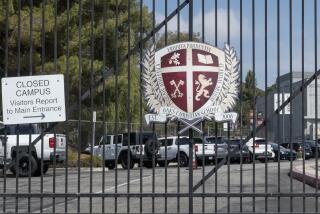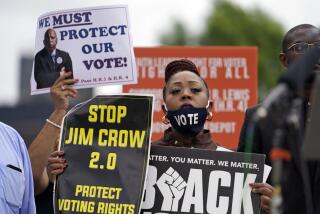Closing the Racial Communications Gap
- Share via
Recent surveys show that at many predominantly white colleges, black and white students continue to be isolated from each other socially in classrooms, dormitories and cafeterias. When I first arrived from the South African black ghetto of Alexandra to attend college on a tennis scholarship in 1978, I was horrified by my discovery that black and white students were almost complete strangers, as if each group attended a different school. All of this was in a place, ironically, where the mutual pursuit of knowledge was supposed to engender greater communication, open-mindedness, better understanding and respect of cultural differences.
I knew from experience the dangers of this separateness. In South Africa it fueled the abomination called apartheid. Apartheid has prevented blacks and whites from knowing each other--and that is why the racism of most whites has become so ingrained that they see nothing wrong in the injustice and human degradation inherent in separate schools, churches, buses, hospitals, neighborhoods and even separate graveyards. Consequently, the lives of many blacks and whites are ruled by stereotypes, half-truths, ignorance, prejudices, unfounded fears and mistaken beliefs.
Early in my childhood I became a victim of these destructive attitudes. I was exposed only to the worst sort of whites--the soldiers who occupied the ghetto and maimed and killed blacks during peaceful protests, and the policemen, who repeatedly arrested my father for the “crime” of being unemployed and then marched my parents naked out of bed while terrorizing us children during midnight raids. Thus, I came to hate all whites.
Luckily, my mother and grandmother, though illiterate, taught me what I have come to regard as the most important lessons in race relations: There are good white people and bad white people, just as there are good black people and bad black people. Black racism is as reprehensible and corroding to the soul as white racism. It is amazing that these women believed this after having suffered repeated indignities at the hands of whites. One time my grandmother, after I had mistakenly stepped into a whites-only bus, had to wipe the steps where I had trod to appease the irate driver who threatened to have us jailed.
In spite of my experiences at the hands of racist whites, the lessons my mother and grandmother taught me saved my life and paved the way for my eventual escape from apartheid. As a teen-ager I made some valuable white friends, some of whom helped in my quest for a decent education and tennis proficiency. An education emancipated me from mental slavery and taught me to believe in my own worth and abilities, despite the South African’s government’s attempt to limit my aspirations and prescribe my place in life through the inferior education system offered to blacks. Tennis became my passport to freedom in America. I continued to encounter white racists, but their bigotry failed to eradicate in me the reality that there were other whites who were different.
Given such a past, when I discovered a form of segregation among students at the colleges I attended, I felt compelled to combat it. I told myself that I hadn’t escaped from apartheid bondage only to end up segregated in America.
I literally forced myself into the consciousness of white students, in ways that sought to reverse their stereotypical images of black students. First, despite my participation in collegiate sports, I put a higher premium on my education. Throughout my college career, I never allowed my grade-point average to drop below 3.0. Each time it threatened to do so, I would cut back on the hours I devoted to sports, even at the risk of incurring the coach’s wrath. This startled some white students, who thought that black athletes were in college only for athletics. This stereotype is largely the result of what Arthur Ashe describes as the “deep-seated cynicism of coddled, black public school athletes.”
In classes where I was often the only black, I participated fully in discussions, asked incessant questions and vigorously defended my opinions. In the cafeteria I sat wherever the conversation was serious, and with whomever I wanted. While I championed the teaching of black studies as a way of enriching the college experience of white students, I valued the great books of Western civilization used in the study of the liberal arts; their contents made me better understand human society, and, by contrast, my African heritage. I volunteered to become the first black editor of the college paper--in spite of the fact that I couldn’t yet type properly. I used the newspaper in part to advocate activism and idealism among black and white students, and to galvanize them around issues of common interest such as bigotry, sexism, war and peace, intolerance and defense of the liberal arts.
My attitude rankled some black students. Some felt that any black student who sat with whites in the cafeteria, worked with them on projects, shared with them black culture and socialized with them was a traitor. In their militant rage at white racism, these students apparently forgot that communicating with each other is one effective way of combatting the cancer of racism. Some white students felt uncomfortable with me because I did not fit their prejudiced view of what a black person is; those whites felt comfortable only around blacks who acted unintelligent and happy-go-lucky. Blacks like myself who were assertive, independent and stood up for their rights were called “uppity” just as similar blacks in South Africa are called “cheeky.”
My college experiences have shown me how a lack of communication and interaction between the races in America forces the same attitudes that have given us legalized segregation and its attendant racism in South Africa. The irony is that in America these attitudes are flourishing 25 years after passage of landmark civil rights legislation and 35 years after the Supreme Court declared segregated education inherently unequal.
Does this mean that South African and American societies are the same? By no means. One major difference is that the United States has outlawed segregation and now equally protects the civil rights of all Americans. Black Americans enjoy a measure of freedom and opportunity undreamed of by their counterparts in South Africa.
But the similarities in the attitudes lead me to believe that racism and its harmful effects will continue to plague American society until blacks and whites begin talking to each other--rather than always about each other. Schools and colleges are one place where this process can start.
More to Read
Sign up for Essential California
The most important California stories and recommendations in your inbox every morning.
You may occasionally receive promotional content from the Los Angeles Times.













